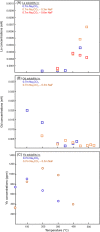Carbonate complexation enhances hydrothermal transport of rare earth elements in alkaline fluids
- PMID: 35304459
- PMCID: PMC8933457
- DOI: 10.1038/s41467-022-28943-z
Carbonate complexation enhances hydrothermal transport of rare earth elements in alkaline fluids
Abstract
Rare earth elements (REE), essential metals for the transition to a zero-emission economy, are mostly extracted from REE-fluorcarbonate minerals in deposits associated with carbonatitic and/or peralkaline magmatism. While the role of high-temperature fluids (100 < T < 500 °C) in the development of economic concentrations of REE is well-established, the mechanisms of element transport, ore precipitation, and light (L)REE/heavy (H)REE fractionation remain a matter of debate. Here, we provide direct evidence from in-situ X-ray Absorption Spectroscopy (XAS) that the formation of hydroxyl-carbonate complexes in alkaline fluids enhances hydrothermal mobilization of LREE at T ≥ 400 °C and HREE at T ≤ 200 °C, even in the presence of fluorine. These results not only reveal that the modes of REE transport in alkaline fluids differ fundamentally from those in acidic fluids, but further underline that alkaline fluids may be key to the mineralization of hydrothermal REE-fluorcarbonates by promoting the simultaneous transport of (L)REE, fluoride and carbonate, especially in carbonatitic systems.
© 2022. The Author(s).
Conflict of interest statement
The authors declare no competing interests.
Figures




References
-
- Chakhmouradian AR, Zaitsev AN. Rare earth mineralization in igneous rocks: sources and processes. Elements. 2012;8:347–353.
-
- Goodenough KM, Wall F, Merriman D. The rare earth elements: demand, global resources, and challenges for resourcing future generations. Nat. Resour. Res. 2018;27:201–216.
-
- Smith MP, et al. From mantle to critical zone: a review of large and giant sized deposits of the rare earth elements. Geosci. Front. 2016;7:315–334.
-
- Borst AM, Friis H, Nielsen TFD, Waight TE. Bulk and mush melt evolution in agpaitic intrusions: insights from compositional zoning in eudialyte, Ilimaussaq complex, South Greenland. J. Petrol. 2018;59:589–612.
-
- Nabyl Z, et al. A window in the course of alkaline magma differentiation conducive to immiscible REE-rich carbonates. Geochim. Cosmochim Acta. 2020;282:297–323.
LinkOut - more resources
Full Text Sources

